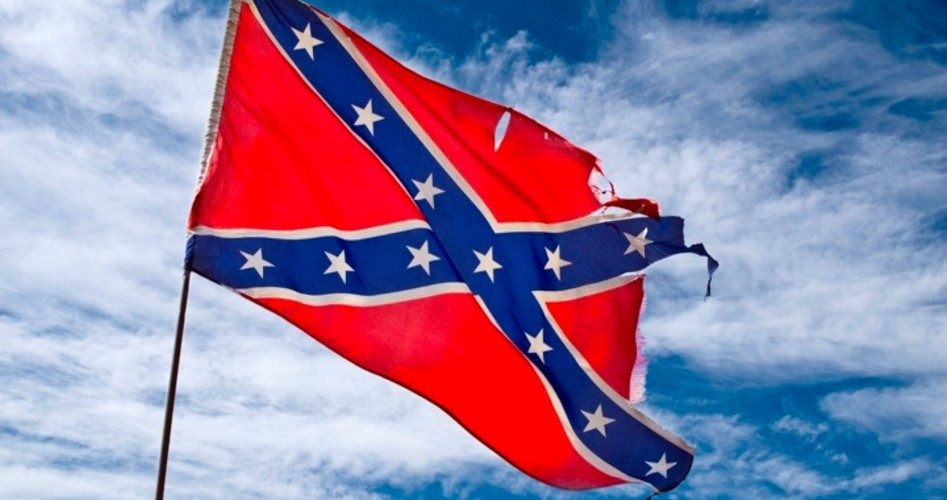
The South has many faces and is symbolized by countless images: pretty girls in hoop skirts walking under live oaks draped with Spanish moss; Tennessee walking horses cantering along white rail fences; young boys angling for catfish; friendly waitresses ready with a smile and kind words: “How are y’all this mornin’? Y’all want coffee?” But from the Mason-Dixon line to the Gulf, there are two universal symbols of the South — “Dixie” and the Confederate battle flag. Both are now under attack, but especially the flag.
As symbols of national identity, flags have always aroused the passions of the people. Like the heraldic emblems often emblazoned on them, flags have long been used in battle to identify the opposing combatants. But why all this fuss over an emblem that is 127 years old?
The latest chapter in a dispute with deep historic roots was launched last December 28th in Savannah, when the NAACP (National Association for the Advancement of Colored People) launched a campaign to remove the Confederate flag from the state capitol buildings of South Carolina and Alabama, and to delete its design from the state flags of Georgia and Mississippi. NAACP Southeast Regional Director Earl Shinhoster held a press conference in the Georgia seaport in anticipation of the opening of the 1988 legislative sessions in the four targeted states, brandishing 16,000 signatures from supporters. During the media event, Shinhoster referred to the Confederate flag as an “odius symbol of a bygone era.” But Shinhoster hit the nail on the head when he identified the issue behind the flag: “It represents state sovereignty, state rights, a rejection or resistance to federal control, and it has an adverse effect on basic issues of human need.”
In the same vein, the president of the Mississippi NAACP, Representative Aaron Henry (D-Clarksdale), announced on December 30th that he would introduce a proposal to remove the Confederate battle flag design from the Magnolia State’s flag, which it has graced since 1894. Henry said the intent of the banner “was to disenfranchise blacks when slavery was in vogue.”
In neighboring Alabama, the state NAACP president, Thomas Reed (D-Tuskegee), and 13 other black legislators were arrested on second-degree criminal trespass charges on February 2nd, while attempting to climb a fence leading to the capitol dome, for the stated purpose of pulling down the Confederate flag. The legislators were released on $300 bonds. The NAACP in Alabama called the battle flag “a racist symbol of oppression and slavery,” but Governor Guy Hunt defended the banner “as a historical symbol of the Old South.” (Montgomery was the first capital of the Confederate States of America, and President Jefferson Davis took his oath of office on its capitol steps on February 18, 1861.)
Making a Federal Case of It
Having failed to have the flag removed from the capitol in Alabama, Representative Alvin Holmes (D-Montgomery) threatened a suit in Federal Court: “[We’ll] challenge the constitutionality of the state of Alabama in its official capacity as a state, flying a flag of a nation that once attempted to overthrow the U.S. government.”
On Sunday February 14th, a conference of about 85 leaders from the Southern Christian Leadership Conference, the Alabama Democratic Conference, the Alabama New South Coalition, Operation Push, and other activists met in Montgomery to hear State Representative and NAACP President Thomas Reed gear up for another round in the fight.
“Reluctantly, I cannot tell you what the next move will be,” Reed told the activists. “I can tell you there will be another effort. You have not seen anything yet. That Confederate battle flag must come down.”
In neighboring Georgia, where, as in Mississippi, the battle flag design is incorporated into the state flag, legislation is periodically introduced to remove the symbol of the Old South, but has never progressed very far. The latest effort to change Georgia’s flag was a bill introduced by Representative Frank Redding (D-Decatur). Judith Damewood, President of the Georgia Common Cause, said she is “embarrassed” by the state flag. “When the Democratic National Convention comes to Atlanta this Summer, this is not the flag I want those delegates to see,” she said.
Across the South, display of the 127-year-old flag has generated sometimes surprising controversy:
• North Carolina Governor Jim Martin has ordered that decorative Confederate flag front bumper plates can no longer be sold by privately-run businesses that also act as state agents for North Carolina state license plates. The action was reportedly taken by the Governor at the prompting of a group of “black business leaders” in Winston-Salem.
• The police department in Franklin, Tennessee has decided to remove the Confederate emblem from police cars and uniforms. Police Lieutenant Bolin Fitzgerald explained: “I don’t think we black officers should have to wear something we don’t represent.”
• Oklahoma Governor Henry Bellmon signed into law a bill providing that 14 flags linked to the state’s history be flown at the state capitol plaza. The flags represent the nations that have controlled Oklahoma throughout its history, including Spain, France, the Confederate States, and the Choctaw Indians. Following opposition from opponents, the pole reserved for the Confederate flag was left empty because, according to the Governor, the bill did not specify which of the Confederate flags to fly. “We’re going to leave that flag pole empty until they [the Legislature] tell us which flag to fly,” said Governor Bellmon.
• In March, 14 students were suspended from Chewning Junior High School in Durham, North Carolina for celebrating “Southern Pride Day” by wearing small Confederate battle flag patches on their clothing. In an affidavit, one of the students, Nickie Pruitt, 14, reported: “Assistant Principal Fred Putney boarded our bus and stated, ‘If you have a rebel flag, stay on the bus.’ He never asked me, or to my knowledge anyone else, to remove the flags from our clothing. None of the students were causing any disruption or commotion, there were no fights or angry words between students, and the only commotion and disruption was due to the refusal of the school officials to allow us into the school ….” Miss Pruitt’s sister, Patricia, 12, who was detained for 45 minutes in a school office, commented: “No one offered me any options, or discussed my conduct with me in any way.”
Attorney Alex Charns, who filed a complaint in Durham Superior Court against school officials, said: “I’m very disappointed that a Durham County 14-year-old read in her civics book that the Constitution gives kids the right to wear black bands with a peace symbol on it, but that public school that taught that to the children then gives a 10-day suspension for basically just doing their homework.”
Durham County School superintendent Larry Coble said that district school policy prohibits students from wearing clothing that is “offensive or potentially disruptive.”
• In South Carolina, the flag issue attracted national attention January 11th when State Senator Glenn F. McConnell (R-Charleston), a leading defender of the Confederate flag’s use, appeared via satellite on NBC’s “Today” show. In the interview with Jane Pauley in New York, McConnell traded opposing viewpoints with the NAACP’s Earl Shinhoster, who spoke from Atlanta.
Shinhoster told “Today” show viewers: “We believe that when Robert E. Lee surrendered the Confederate battle flag in 1865 at Appomattox he asked all Southerners to furl their flags, that he did so in good faith and in a gesture of reality of the times and now we don’t want to bring it back.”
Senator McConnell told the same audience: “The flag is the emblem of our ancestors. It’s the flag they saw across the battlefield and is an emblem of unity and now it flies as a war memorial for those folks who went off to battle.”
What Is the Real Issue?
We have heard the opposing sides of the controversy describe the Confederate battle flag as either an “odius symbol of a bygone era” or as “the emblem of our [Southern] ancestors” and “a war memorial.” Curiously, both sides would agree with Earl Shinhoster’s statement that the flag “represents state sovereignty, state rights … resistance to federal control….”
When McConnell was asked whether the Confederate flag had become the symbol of “hate groups,” he replied: “It has been misused now really by two groups — one the NAACP trying to make it a symbol of racism and of course the Ku Klux Klan, which has no right to the flag, trying to carry it. But they [the Klan] take other symbols like the American flag and the Christian cross … we cannot allow them to take this [Confederate] flag for eternity and turn it into something the people who carried it never intended it to be.”
What was the Confederate battle flag intended to be? To start with, there were several flags used by the Confederate States of America. A proper interpretation of their intended symbolism would require a thorough understanding not only of the four years of the Confederacy, but of the preceding 74 years of the American Republic. Indeed, no explanation outside the context of the history of Western Christian civilization would suffice.
The reason the flag issue cannot be studied in a vacuum is that complete understanding depends on an appreciation of the intent of the Southern people, which is heavily influenced by their unique culture. The Southerner is the heir to a code of conduct that originated in Christian Europe during feudal times. This code of chivalry, familiar to any student of European history, is described by Richard M. Weaver in The Southern Tradition At Bay as “a romantic idealism closely related to Christianity, which makes honor the guiding principle of conduct.”
This concept is particularly difficult for the urban Northerner to understand. Infected by the cynicism of the mercantile way of life, he finds it incomprehensible that virtues such as nobility and sincerity can predominate in any society. The world-weary skeptics of the Northern (and even some Southern) cities look for hidden motivations behind the Southerner’s defense of his way of life, preferring to believe the popular myths rather than the straightforward explanations. Always, the subject of race is interjected: The War Between the States is not seen as a defense of state sovereignty, but of the economic system of slavery. And the natural desire of tradition-minded Southerners to cling to a vestige of their cultural heritage — flying the flags of the Confederacy, singing the song “Dixie” — has been misinterpreted as a latent desire to reinstitute the dreadful system of slavery. (One might just as logically say that those New Englanders who commemorate the American Revolution by flying the Bennington battle flag and by marching in fife and drum corps playing “Yankee Doodle” are really longing for the return of the system of indentured servitude, debtors’ prisons, and smallpox epidemics!)
The Bad Old Days
The Southerner has far more reason than his Northern counterpart to regret the ravages of war that destroyed his world. For he suffered not only the military casualties, but the wholesale destruction of Sherman’s armies; the humiliation of Federal occupation troops for 12 years after the war (including the occupation of New Orleans by the notorious General Benjamin “Beast” Butler, whose unchivalrous Order No. 28 insulted Southern womanhood); and the looting of what was left in Southern state treasuries by corrupt, carpetbag governments. No Southerner is nostalgic about these events!
In retrospect, many leading Southerners were against a war between North and South. Mississippi Senator Jefferson Davis urged President Buchanan to withdraw the small garrison at Fort Sumter rather than risk a conflict. The newly inaugurated President Davis sent peace commissioners to Washington in early 1861 to attempt to settle differences at the conference table rather than on the battlefield, but President Lincoln would not receive them.
And Robert E. Lee’s heart was heavy as, just prior to the outbreak of the War, he told a fellow officer: “I shall never bear arms against the Union, but it may be necessary for me to carry a musket in defense of my native state, Virginia….”
In the Southern mind, therefore, the war was a defense of his state against the usurpation of the general government. The objective of the Confederacy was not to invade the North, nor to overthrow the government in Washington, but to defend the Southerner’s native soil against military enforcement of a Federal authority that the Southerners rejected as illegitimate. It was the culmination of the dispute over the doctrine of nullification that had been going on since 1832, when South Carolina nullified the Federal Tariff Act. (This doctrine held that the states, as voluntary parties to a compact, the Constitution, delegated certain specific powers to the Federal Government and reserved all other powers of government to themselves. The nullifiers declared that, when a conflict arose, the States, rather than the U.S. Supreme Court, should determine the extent of federal authority.)
The Quest Continues
Many issues related to state sovereignty remain unresolved — where, for example, does the Federal Government have the right constitutionally to dictate state polices on employment, health, education, welfare, housing, etc.? (A search of the Constitution will produce no such authority.)
Because these issues are as contemporary today as they were in 1832 or 1861, tradition-minded Southerners and defenders of state sovereignty have two reasons for wanting to honor those who have preceded them in the fight: (1) to honor those who sacrificed in the past, and (2) to inspire those who are continuing the same fight in the present.
Recent polls taken in the two states flying the battle flag from their capitols show that not only a large majority of white citizens (69 percent), but a substantial minority of black citizens (32 percent in South Carolina, 28 percent in Alabama), prefer to keep the flag flying. If not for the false explanations broadcast about the meaning of the flag, the figures for both races would undoubtedly be much higher.
One thing is certain: Respect for the heritage and traditions of the South is still strong. But the greatest Southern tradition of all is not the Confederate battle flag, but the battle for state sovereignty that was fought under it.
That battle is far from over and the participants in the fight have no intention of striking their colors until constitutionally limited government is restored.



